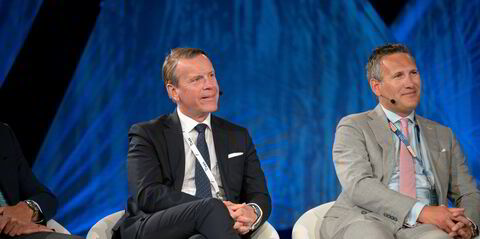After exiting Det Norske Oljeselskap (DNO), Torstein Hagen made his cruise comeback in 1997 with the purchase of four Russian river vessels together with Finnish and Swedish interests.
Viking Cruises’ longboat fleet now numbers 59, with three on order and three options. The decision to move into ocean cruising has resulted in three Fincantieri-built, 930-passenger vessels in the water and seven on order, including two options, all in Italy.
Hagen acknowledges that such rapid growth is quite an achievement.
“It’s unbelievable,” he said. “If someone had written the script for this, I’d have said it can’t be done. We’ve been extremely fortunate.”
Given the competition for cruiseship newbuilding slots and eager buyers, would Hagen consider selling any of the vessels?
“No,” he said firmly. “We spent a lot of time and money on the design. That’s paid off and that’s why we’ve made them identical.”
He says there were no big challenges in the build process.
“Nothing. It just happened,” he said, while applauding his “first-class team”.
“I’ve got a very strong righthand man called Jeff Dash, who works day and night and negotiates like a devil,” he said.
He also mentions John Rusten and Erling Frydendburg, head of development and new construction and of hotel operations, respectively — both very experienced.
“It started in 2012," he said. "We thought we had a deal with STX but they couldn’t finance it. Then we went to Meyer [Werft], who’ve built 50 of our longships, and I had a handshake with them.
"Then the Italians came and gave us an offer we couldn’t refuse. That happened within a week. The timing couldn’t have been better. We got two option two and then we rolled that forward. Now we’re up to 10."
The first ships cost around $300m each but Hagen says the latter ones will be a tad more expensive.
“It’s important the yard makes some money too, and we’re making money,” he said.
Asked if this success had been down to his leadership qualities, Hagen answered: “No, it demonstrates luck!”
He clearly does not believe in bad luck.
“We make our own bad luck," he said. "When things go bad, it’s because you’ve done something wrong. But I do believe in good luck, and we’ve been lucky.”
Hagen stresses that Viking Cruises is more of a marketing company than a shipping one, with a huge database and an annual marketing spend of $230m. Its focus is on brand awareness.
“People say there are only two cruise lines with a true brand in the US – Disney and Viking,” he said. Although, he added: “They’re probably friends of mine!”
With a booming market, and the prospect of further growth in China, is the sky the limit for cruise? Hagen says not.
“I’m optimistic," he said. "We’ve found a niche. We have brought cruising back to what it should be."
He flags up another source of inspiration — Warren Titus, who founded Royal Viking Line in 1972.
“He invented this type of cruising — where you want to go, places to see, learn and experience,” he said.
Hagen definitely rules out bigger ships.
“Many people have come to realise that small is better,” he said.
Finding the optimum size is key — “large enough to be profitable but small enough to be comfortable”.
Hagen says the major difference between cruise and cargo shipping is “elasticity” of demand. In a struggling offshore or cargo market, you cannot create demand. But in the cruise sector, demand is very elastic.
“If you have a little bit too much capacity, you can always create demand by reducing prices,” he said.
He notes there are two types of shipping in the industry as a whole: industrial and “opportunity shipping”.
“With opportunity shipping, you make your money by buying and selling at the right time. Asset play," he said. "In industrial shipping, you have to have expertise, like we have in marketing.”
He recalls asset play was easy during his time at Bergens Dampskibsselskab (BDS).
“We were among the first to do good analysis of supply and demand," he said. "Rolf Skaarberg, Bjarte Kvale and I, we had good models ourselves. Now every Tom, Dick and Harry has a model for supply and demand, brokers and all that."
He believes cycles will be flatter in future and opportunities less — “unless you have brass, brass balls".
Hagen certainly was not born with a silver spoon in his mouth, growing up in “a little red cottage” in Nittedal north of Oslo. He studied theoretical physics at the Norwegian Institute of Technology (NTH) in Trondheim and afterwards took a master of business administration (MBA) at Harvard Business School. His thesis at NTH was on artificial intelligence.
“I programmed a machine to play chess with itself and learn how to play better," he said. That was 1966. So I was ahead of my time.”
As for role models in business, he said: “I was fortunate to have a phenomenal boss at McKinsey who was a huge inspiration. He is dead now but he gave me the feeling that nothing is impossible.
“You just have to decide what you want. The moment you’ve decided where you want to go, the rest is just work.”
Regarding other companies that he admires in shipping, Hagen said without hesitation: “AP Moller-Maersk. Very outstanding.”
He says “focus, dedication and vision” are essential to success. He notes the difference between a leader and a boss is understanding that you cannot do everything yourself.
“I’m not a typical operator," he said. "I have a somewhat uncanny ability to see down the road."
Hagen says he no longer has any consuming interests outside Viking Cruises.
“I used to be a physicist and tried to be current," he said. "This is enough for me."
Finally, asked if there is one thing he passionately believes that no one else does, Hagen replied: “I think what I said before: it may take time, it may cost money, but nothing is impossible.”


